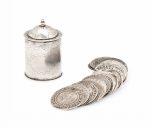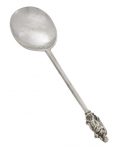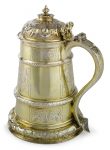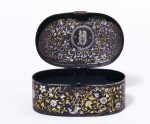Although Elizabethan and Jacobean silver was mainly used for ecclesiastical silver and coins the rapid growth in population and expansion of the middle and upper classes lead to a significant increase in the demand for domestic silver. During the period 1600–1800 the production of silver in the British Isles served a growing class of people who could afford such objects, from magnificent ornate objects to ordinary tablewears. It was often customary to carry personal eating utensils when travelling. This gave rise to the Seal Top Spoon as it was a useful and convenient way to seal documents on route. These spoons were often manufactured with the owner’s seal on the end of the handle. Elizabethan and Jacobean Silver ranged from domestic wares, church items such as chalices and jewellery. Elizabethan silver, is often decorated with embossed sculptural vegetal forms, fruit, grotesque figures, and strapwork. Jacobean Silver tended to reflect the preferences of the monarch James I of England and VI of Scotland. These were more conservative. Norwich Silversmiths were renowned for their secular silver and produced some outstanding pieces. Elizabethan Norwich made plate is often equal to the best London plate of that period. Many silver makers used marks rather than initials during this time. Such marks are the Orb and Cross, Flat Fish, and Sun in Splendour.
AN ELIZABETH I SILVER SEAL-TOP SPOON by Nicholas Bartholomew, London 1581 Conventional form, with tapering stem and fig-shaped bowl, the lobed baluster finial with flat disc terminal, length 15cm, together with another Elizabethan provincial silver wrythen-top spoon, unascribed maker’s mark M enclosed in a circle, York 1564 see Jackson’s p. 460, conventional form, tapering stem and fig-shaped bowl, the gilded and lobed twisted finial with a globular terminal, length 15cm, weight 1oz.
Sold for £ 3,250 inc. premium at Bonhams in 2014
Wiggenhall St German’s Cup / Chalice. Silver; slightly ornamented with inscription. Made by: Buttell, Thomas (his mark of a flatfish (butt) as a pun on his name) Date 1567-1568 (hallmarked C date letter) Made in: Norwich (Norfolk)
Reference: © The Trustees of the British Museum
AN ELIZABETH I / JAMES I SILVER COUNTER BOX MAKER’S MARK ONLY OF MONOGRAM LB OR RB CONJOINED, IN SHIELD-SHAPED PUNCH, BEGINNING OF 17TH CENTURY Cylindrical with pull-off domed cover, sides engraved with a wide band of intersecting alternate lozenge and navette motifs framing zig-zag decoration, the cover engraved with radiating stiff leaves, the rim engraved with chevron motifs forming an eight-pointed star, knop finial, marked inside base of box and containing 41 Elizabethan coins mostly dated between the 1560s and 1580s 2 in. high (5 cm.)
Sold for GBP 1,875 at Christies in 2014
James I Sterling Silver Apostle Spoon Maker’s mark rubbed, London, 1617 With fig-form bowl, the parcel gilt terminal depicting St. Andrew. Height 7 inches (17.8 cm.), approximately 1 ounce, 10 dwt. With wear to hallmarks, the maker’s mark illegible; with light wear to figure, possibly regilt
Sold for $1,000 (includes buyer’s premium) at Doyle New York in 2017
An Elizabeth I silver-gilt tankard, maker’s mark a slipped rose, London, 1578 tapered cylindrical, applied with two midbands, base rim chased with strapwork and swags of flowers and fruit, the sides engraved with panels of strapwork and the front with arms, hinged cover chased to match, scroll handle engraved with scrolls, cast angel with cornucopia thumbpiece marked on base, traces of marks on cover height 6 3/4 in. 17.2 cm 14 oz 435 g
Sold for 65,000 USD at Sothebys in 2017
Object Type This small box was designed to contain sweetmeats which in the 16th century were given as presents at New Year. This may explain why a comparatively humble object should be dated. People Inside the lid, inlaid in silver, is the crest of Robert Dudley, Earl of Leicester (died 1588) the favourite of Elizabeth I. This box must have been made specially for him and was almost certainly given to him as a present. Curiously the box was never opened in the museum until 1968 when the crest was seen for the first time. Materials & Making The box is decorated in a technique known as damascening in which gold and silver ribbon is pushed into the cross hatched surface of iron using a copper tool. The iron was darkened to a blue or black colouring using heat or chemicals to contrast with the gold and silver ornament. In the 16th century this technique was especially popular in northern Italy for the decoration of arms, armour and wrought iron
Reference: © Victoria and Albert Museum






